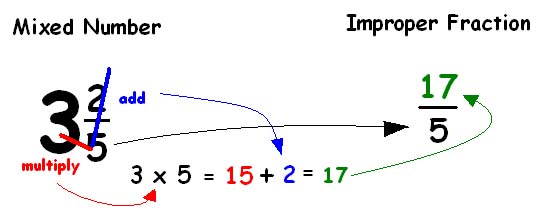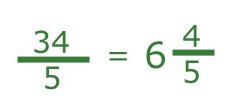Fractions and Mixed Numbers
 |
Converting fractions and mixed numbers is as easy as a simple check mark. To turn a mixed number into an improper fraction, you first want to multiply the whole number and the denominator. Then take that number and add it total to the numerator. That number is the new numerator. The denominator stays the same as it was listed originally. Let's take a look at an example...
|
| Example of the Check Mark Method |

| Were you able to follow the color coded diagram above? You need to multiply the first two numbers of the check mark, and then take that answer and add it to the last piece of the check mark .
If you need to add, subtract, multiply or divide, you can always convert the mixed number to an improper fraction first. So make sure you are able to convert fractions and mixed numbers.
Improper fractions are easier to do operations with than mixed numbers. |
|
|
However, some teachers will require that you never leave an improper fraction. If this is the case, then you must convert the improper fraction back into a mixed number.
Thats as simple as dividing the numerator by the denominator and putting the whole number "outside" the fraction and placing the remainder over the current denominator. Here is an example:

To make sure that you divided correctly, you can always check you work real quick by doing the check mark method. So 6 x 5 is 30. Add that to the numerator of 4 and put it on top of the denominator of 5 and you have 34/5! Once you do this method a few times, it will become second nature. Don't forget: make sure to reduce your fraction to simplest terms!
Do you need help with multiplying and dividing? |
|
|
Make sure you practice your skills with free fraction worksheets.
Return to the Grade A homepage.
|




